Bridgestone Potenza Sport vs Michelin Pilot Sport 4 & 4S: Both are high-performance summer tires and due to their robust tread compounds, these tires maintain functional traction even in high temperatures during blazing summer and provide an optimized driving experience on dry as well as wet paths.
Michelin Pilot 4S offers smooth driving on-road, owing to its awesome grip on dry and wet pavement.
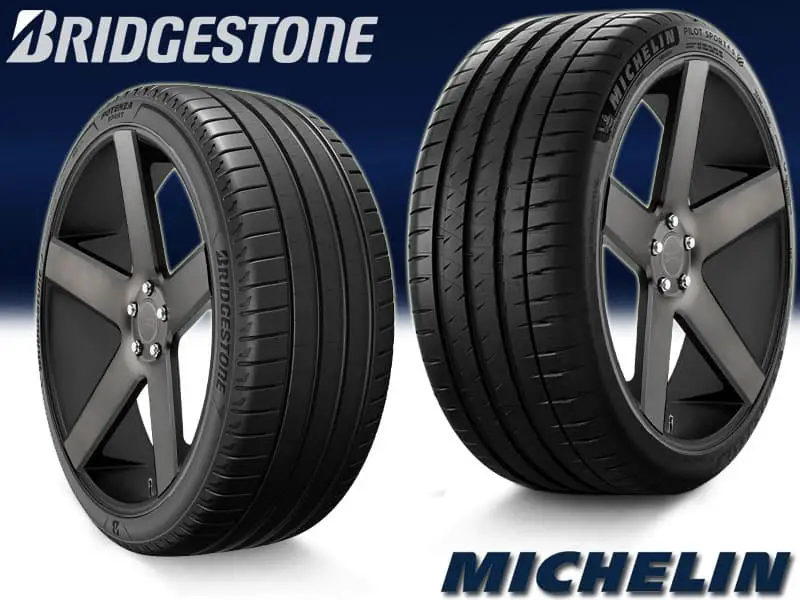
Examine the treads on these tires closely. They hold the key to knowing which to choose. In fact if you visit my "tread design" page, picking the right tire would never bother you.
On the other side, Potenza provides firm handling on the slippery road and shows better fuel economy.
The Pilot sport 4 provides a sound and stable handling over slippery, wet tracks.
Lets compare Potenza Sport with Michelin Pilot sport 4 and 4S.
Table of Contents
Bridgestone Potenza Sport vs PS4S
Bridgestone Potenza Sport
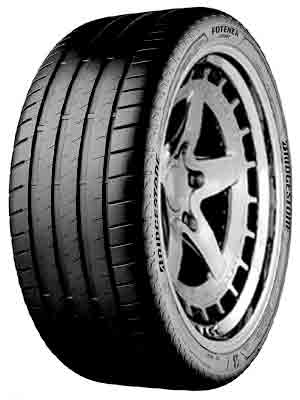
Michelin Pilot Sport 4s


Vs

Michelin Sport 4S characterizes an asymmetrical tread with deep grooves of different widths, uninterrupted tread ribs marked with crisp sipes along their edges, and bulky shoulders. Its contact patch is higher than its competitor due to the presence of grooves with varied broadness, hence, it shows better grip on dry surfaces. While rolling on wet tracks, increased depth of sipes and voids give it the advantage of better hydroplaning resistivity and account for a firm grip on a wet road as well. However, a comparatively lesser number of lateral grooves among shoulders make it stand behind in competition while concerning wet tracks.
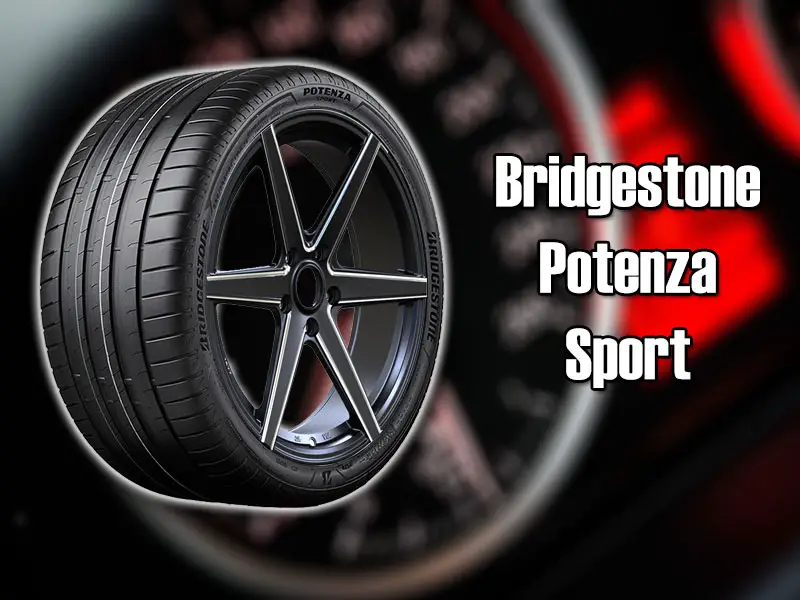
Bridgestone Potenza has a classic summer-tire look with three continuous, circumferential ribs in the central part, four grooves, curvy sipes along edges of central ribs, and large shoulders on their sides. A high void ratio due to broad grooves decreases its contact patch and result in lesser dry grip in comparison. It shows a reliable wet grip as it has wavy sipes, one narrow and three broad grooves to evacuate water through the tread, and resists hydroplaning, however, lesser tread depth reduces its water holding capacity and makes its grip on wet roads lesser than its competitor.
Road Grip Comparison
Pilot 4S shows a superior capacity to grip on the dry road due to its low void ratio. As two of its grooves are less wide, its contact patch is maximized and tread holds on the dry surface strongly while moving over the pavement. It covers only 78.10 feet when brakes are applied at the speed of 50 mph. Comparatively, a smaller wet braking distance of 114.80 feet when stopping from 50 to zero mph makes 4S a better choice for a road trip on a rainy day. It has deeper grooves and sipes which provide efficient water removal on a wet road as compared with its competitor.
Potenza exhibits a lesser contact patch because it has three broad grooves and only one groove with a smaller width, therefore, its tread grips over the dry surface is less strong than its competitor. It covers a comparatively larger braking distance of 80.20 feet when stopping from 50-0 mph on a dry road. On a wet road, its sipes and voids provide hydroplaning resistance by wiping off the water but its ability to do so is lesser in comparison due to its relatively lesser tread depth. Its wet braking distance is recorded 120.10 feet when it comes to rest from 50 mph on a wet road.
Interesting to note: The Pirelli P Zero PZ4 was still able to perform better than Michelin Pilot Sport 4 but not 4s.
Handling Comparison
Both of these tires show good ability to manage steer response on a dry road as both have bulky shoulders. However, Michelin 4S has an even larger contact patch of shoulders which results in more lateral stability and fully controlled dry handling along a corner. Its lap time is estimated at 30.08 seconds. On the other side, high contact patch makes the void ratio lower because it has a comparatively less number of sipes along its shoulders to account for wet traction and this eventually leads to less firm steer handling than its competitor. Its lap time on a wet road is 33.82 seconds.
Potenza sport has more voids among its relatively smaller shoulder lugs as a result contact patch of its tread is reduced, leading to lesser traction when the vehicle moves along a corner on a dry road. Its lap time on a dry track is 30.38 seconds. Conversely, its wet handling is supreme as comparatively more grooves and sipes are marked among its shoulders and their water wiping efficiency offers more stability and control while taking turns on the wet road. Its lap time on a wet road is recorded 33.46 seconds.
Comparison of Hydroplaning Resistance
Sport 4S provides supreme resistance against hydroplaning due to its higher tread depth. Its relatively deeper voids offer more vacuum for channeling water easily through the tread and safeguard the vehicle from slipping off on a wet road.
In comparison, Potenza has relatively broad but shallow grooves (there is a difference of 1.5/32’’ in tread depth of tested sizes), leading to reduced ability to hydroplaning resistance as its channels offer lesser space for the removal of water, owing to their lower depth.
Comparison of Rolling Resistance
Owing to its relatively low void ratio, Pilot 4S faces more friction while rolling over the road because more area of tread is connected with the surface directly. Hence, more fuel is required to compensate for the energy lost while overcoming this resistance.
The high void ratio of Potenza reduces the contact patch of its tread which faces lesser resistance while rolling over. As less hysteresis (energy loss) is produced while moving, consequently, less amount of fuel is consumed.
Comfort and Noise Comparison
Sport 4S produces lesser noise on road due to its high contact patch and low void ratio. Half of its voids are narrow and offer only a little space for the resonation of air particles, leading to minimal tire sound when it rolls at high speeds. Due to increased contact patch and tread depth, it provides better grip and more comfort while driving on road.
Potenza is a relatively noisier tire as a smaller contact patch has made its void ratio higher. It has more broad grooves which present free space for reflection and resonation of sound waves through them, leading to loud noise. The ride comfort offered by Potenza is relatively lesser due to its reduced on-road traction owing to its lesser contact patch.
Durability and tread wear
Although Sport 4S faces more rolling resistance yet its sturdy tread composition makes it a more durable summer tire in comparison. Its tread features side-by-side Le Mans-derived compounds such that the low void side utilizes a dry-focused hybrid rubber while the other side is a silica-infused wet compound. Internal construction employs a single-ply polyester with cord filament, twin high-strength steel belts reinforced by a spirally wound Nylon hybrid. This blend of sturdy polymers enables the tread to withstand dry conditions, road friction as well as chips and bruises, leading to slower wear. It is also backed by a mileage warranty for tread life up to 30,000 miles.
Potenza is also a fairly durable tire due to its reinforced internal construction. Its tread is made from a one-ply polyester casing with twin steel belts which are further strengthened by an Aramid-Nylon cap ply. However, its tread polymer is not as strong as its competitor’s, so, it wears down relatively quickly. It does not have any treadwear warranty from its manufacturer.
Price
Potenza sport is more budget-friendly among these tires as it is not only priced lesser but also has the advantage of a better fuel average. On the other side, Michelin 4S costs a little higher but also exhibits superior on-road grip and has a tread life warranty as well.
Comparing Michelin Pilot Sport 4 with Bridgestone Potenza Sport
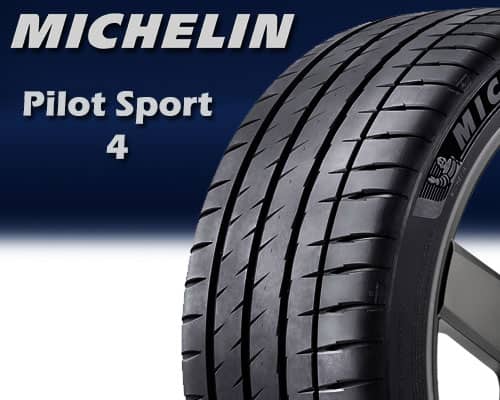
Vs

Potenza has a 5-pitch tread design with 4 circumferential grooves dividing the tire into 5 columns. Three of these grooves are wide but the fourth one is a lot narrower. Deep sipes form the border between its shoulder blocks instead of lateral grooves.
It has three ribs with no tread block column. Small thin sipes are available on the right side of all the ribs.
Pilot Sport 4 has four circumferential grooves dividing the tread into 5 columns. Its fourth groove is as thin as a line while the others are wider. The lateral grooves define its shoulder blocks and these blocks have no sipes available on them. It has 3 ribs with no tread blocks column. The Inboard intermediate rib has no siping while the central rib has small sipes in the outward direction only. Its outboard intermediate rib has small sipes in the alternating direction.

Road Grip Comparison
Central ribs of Potenza are bulkier in comparison due to their relatively higher width. A higher contact patch enables the tread to hold on strongly over the dry paved surface. Coming from 100-1 km/h it covers a braking distance of 109.5 feet. Its ribs possess an increased number of curvy sipes which wipe off water along with grooves, making wet grip superior and wet braking distance lower. It covers only 114 feet when slowing down from 60 to 0 mph.
Michelin Sport shows a reliable dry grip owing to its continuous ribs; however, it loses from its competitor as a relatively high void ratio makes the contact patch relatively lesser. As a result, the dry grip of tread is minimized, and the tire covers a relatively higher braking distance. Its braking is recorded at 111.3 feet when decelerating from 60 mph. On wet pavement, fewer sipes over ribs and a lesser contact patch makes its grip lesser than the competitor because sipes are missing from one edge of a tread rib while the other one lacks siping completely. It has 115 feet of wet braking distance, coming from 60 mph.
Handling Comparison
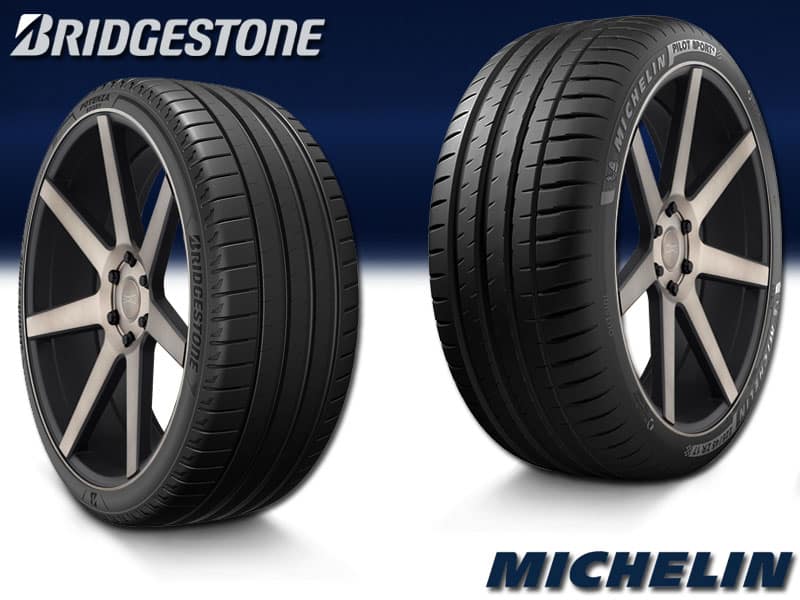
Taking the advantage of its massive shoulders, Potenza shows a better steer response while taking turns over dry paved roads. Its shoulders hold on the surface strongly while turning along due to their relatively higher grip. Its lap time on a dry road is recorded 94.34 seconds. However, its wet handling efficiency is lesser than its competitor because of decreased tread depth. Its lap time on wet pavement is 64.53 seconds.
Michelin stands behind in the competition when it comes to dry handling as the grip of its shoulder lugs is relatively lower, leading to lesser stability while steering along the corner. Its lap time on dry pavement is 94.87 seconds. On the other side, relatively deeper lateral grooves remove water from the surface efficiently and present a fully commanded steer response on the wet road. On a wet track, its lap time is recorded at 64.46 seconds.
Comparison of Hydroplaning Resistance
Both of these tires have full-depth sipes, four circumferential grooves, and numerous lateral voids to account for aquaplaning resistivity. Potenza performs lesser in this respect, however, as its tread depth is relatively lower (for the tested size, the difference is 1.5/32’’). Decreased depth of voids accounts for its reduced water holding capacity and lesser hydroplaning resistance.
Pilot Sport takes the lead in terms of hydroplaning resistance due to its increased tread depth. Its deeper voids offer large space for channeling out water through the tread and reduce the chances of slipping on a wet road due to aquaplaning.
Comparison of Rolling Resistance
Potenza has a relatively larger contact patch due to its wider central ribs as well as larger shoulders, as a result, more friction arises when it rolls over the paved surface. Its fuel efficiency is comparatively low as more fuel is needed to account for the hysteresis (energy loss) produced. 9.47 kg/t resistance is recorded for its tested size.
Pilot Sport exhibits a high void ratio due to which its contact patch has been minimized. Less surface area of tread in contact with road encounters lesser rolling friction, as a result, less energy is consumed for its movement. This property makes Pilot 4 fuel-efficient in comparison. It faces 8.56 kg/t resistance while rolling.
Comfort and Noise Comparison
Potenza is a comparatively louder tire. During the test, its noise level is recorded at 71.7 dB. However, in terms of comfort, it wins the game as it offers superior traction on the dry road as well as has a first-class ability to grip over the wet roads.
Sport 4 makes lesser noise in comparison. Its noise level is 70.8 dB for the tested size. Comparatively, it offers a less comfortable ride as its road grip is minimized by its lower contact patch.
Durability and Treadwear
Potenza is rated as a moderately durable summer tire. It is constructed from a 1 ply polyester along with two steel belts which are reinforced by one ply of nylon hybrid cap. However, its polymer compound is less sturdy than its competitor. Moreover, it does not come with any mileage warranty for its tread life.
Pilot Sport takes the winner slot for its longevity and slower wear. Its tread composition includes a single ply of robust polyester rubber with functional elastomers and silica which is reinforced by an Aramid-Nylon hybrid belt. Moreover, the Premium Touch design of sidewalls further adds to its chip and wear resistance. It is backed by a mileage warranty up to 20,000 miles from Michelin tires.
Price
Although there is not much difference in prices for both of these tires yet Pilot 4 is priced comparatively higher. Nevertheless, this purchasing expense comes with the long-term benefits of fuel-efficiency and longer tread life. On the other side, you can save a few bucks and still enjoy your summer trip with max-performance Potenza.



